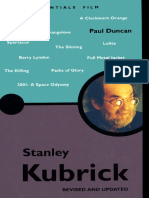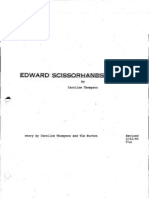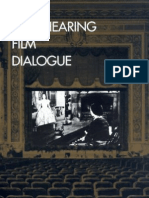Stanley Kubrick's Theory of Narrative
Stanley Kubrick's Theory of Narrative
Uploaded by
Matt JenkinsCopyright:
Available Formats
Stanley Kubrick's Theory of Narrative
Stanley Kubrick's Theory of Narrative
Uploaded by
Matt JenkinsOriginal Description:
Original Title
Copyright
Available Formats
Share this document
Did you find this document useful?
Is this content inappropriate?
Copyright:
Available Formats
Stanley Kubrick's Theory of Narrative
Stanley Kubrick's Theory of Narrative
Uploaded by
Matt JenkinsCopyright:
Available Formats
Stanley Kubricks Theory Of Narrative
2001: A Space Odyssey (Directed by Stanley Kubrick)
Stanley Kubrick insisted that a feature film can be constructed from six to eight nonsubmersible units. A non-submersible unit is a fundamental story sequence where all the nonessential elements have been stripped away. These units would be so robust and compelling that they would, by themselves, be able to keep the viewer interested. They would contain only what is necessary for the storyline. And when joined together they would form a greater narrative. Kubricks ideas on cinematic narrative seem to have been formed at an early stage, as far back as 1960, where he summed up his approach: I think the best plot is no apparent plot. I like a slow start, the start gets under the audiences skin and involves them so that they can appreciate grace notes and soft tones and dont have to be pounded over the head with plot points and suspense hooks. The way Kubrick reduced 2001: A Space Odyssey to its most important elements was indicative of his emerging method of telling stories. Over the years, Kubrick had adapted many books into films. By the time he came to conceive of 2001: A Space Odyssey he realised that all he needed as he later told science-fiction writer Brian Aldiss are six or eight non-submersible units: basic story points that cannot be reduced any further. When the story points are linked together they form a narrative that will contain a balanced mix of all the themes, images and characters.
On release in 1968, Stanley Kubricks 2001: A Space Odyssey polarized critical and public opinion. Many of its admirers considered it a prophetic masterpiece while its detractors praised
the special effects but found it confusing and disappointing as drama. The final scenes in particular remained for many an enigmatic, purely emotional, non-verbal experience. Indeed, less than half the film had dialogue. It was a re-organization of the traditional dramatic structure. Process became more important than plot. As one critic put it: It was a film not about space travel; it was space travel. Kubrick retorted: The feel of the experience is the important thing, not the ability to verbalize or analyze it. Notably, 2001: A Space Odyssey was Kubricks first experiment with restructuring the conventions of the three-act drama. Its likely it started out to be something quite different. The book based on the original screenplay by Arthur C. Clarke and Kubrick is literal, more explicit. The film, in its early stages, had a narrators voice. It was cut gradually and then eliminated completely, by virtue of which 2001: A Space Odyssey evolved as a more visual experience.
By the time Stanley Kubrick began working with Brian Aldiss on A.I. Artificial Intelligence (eventually filmed by Stephen Spielberg) Kubrick had formulated his theory of storytelling. As Aldiss recalls, Kubrick told him: To forget about the narrative, you dont want narrative, just concentrate on various scenes. He then expounded his theory of non-submersible units you can see it working out in particular in 2001 so where there are these chunks of narrative. This I believe is one of the attractions of 2001 not only the music, not only the extraordinary silences and the beauty of the photography, but the fact that they dont quite fit together. This gives the film a sense of mystery, so the intelligent viewer has to construct their own narrative. In an interview for the documentary Stanley and Us, Brian Aldiss expanded on Kubricks notion of constructing a film based around a succession of irreducible sequences: I was always keen on the idea of narrative. My books always have a narrative. That is to say, cause and effect. Thats what I like. But Stanley was less interested in that and he said to me now forget about the narrative. He said what you need to make a movie is six nonsubmersible units. That was the phrase he used: non-submersible units. And he said when weve got those were away. And I did actually produce one [a script] that he loved and was really enthusiastic about. It was the one time in our working relationship when he was enthusiastic and he said to me Brian, I have the impression that you have two styles of writing one is brilliant and the others not so good. But when you think about this philosophy of the non-submersible unit you can see it in action most effectively, I think, in The Shining. You have an episode and then its linked to another by a blackboard that would just say Thursday, Four PM. You know something bad is going to happen on Thursday at Four PM. It heightens the suspense and so in that respect its a very good device. But when you examine 2001, you can see
the non-submersible units and they dont actually quite link up. For instance, the last mysterious episode is almost complete in itself. And then theres the episode on the ship with HAL. These are the units. And its because they dont link up that we find 2001 so interesting. Theres something that our intellects cant quite resolve and thats an attraction in a movie.
Thus 2001: A Space Odyssey can be understood as a break with traditional cinematic narrative, an attempt to remove itself from a conventional way of telling a cinematic story. It was a new way of assimilating narrative. 2001: A Space Odyssey was not an articulated plot but a succession of vivid moments. In the case of the narrative structure of 2001: A Space Odyssey one can distinguish four such sections or units: The Dawn of Man, an untitled second section, the third section called Jupiter Mission 18 months Later, and finally Jupiter and Beyond the Infinite, with each section separated by a narrative ellipsis. This visual approach to storytelling was later discussed by Stanley Kubrick in an interview with Playboy Magazine in which he elaborates on the intention behind the non-conventional narrative of 2001: A Space Odyssey:
PLAYBOY: Much of the controversy surrounding 2001 deals with the meaning of the metaphysical symbols that abound in the film the polished black monoliths, the orbital conjunction of Earth, Moon and sun at each stage of the monoliths intervention in human destiny, the stunning final kaleidoscopic maelstrom of time and space that engulfs the surviving astronaut and sets the stage for his rebirth as a star-child drifting toward Earth in a translucent placenta. One critic even called 2001 the first Nietzschean film, contending that its essential theme is Nietzsches concept of mans evolution from ape to human to superman. What was the metaphysical message of 2001?
KUBRICK: Its not a message that I ever intend to convey in words. 2001 is a non-verbal experience; out of two hours and 19 minutes of film, there are only a little less than 40 minutes of dialog. I tried to create a visual experience, one that bypasses verbalized pigeonholing and directly penetrates the subconscious with an emotional and philosophic content. To convolute McLuhan, in 2001 the message is the medium. I intended the film to be an intensely subjective experience that reaches the viewer at an inner level of consciousness, just as music does; to explain a Beethoven symphony would be to emasculate it by erecting an artificial barrier between conception and appreciation. Youre free to speculate as you wish about the philosophical and allegorical meaning of the film and such speculation is one indication that it has succeeded in gripping the audience at a deep level but I dont want to spell out a verbal road map for 2001 that every viewer will feel obligated to pursue or else fear hes missed the point. I think that if 2001 succeeds at all, it is in reaching a wide spectrum of people who would not often give a thought to mans destiny, his role in the cosmos and his relationship to higher forms of life. But even in the case of someone who is highly intelligent, certain ideas found in 2001 would, if presented as abstractions, fall rather lifelessly and be automatically assigned to pat intellectual categories; experienced in a moving visual and emotional context, however, they can resonate within the deepest fibers of ones being.
PLAYBOY: Without laying out a philosophical road map for the viewer, can you tell us your own interpretation of the meaning of the film? KUBRICK: No, for the reasons Ive already given. How much would we appreciate La Gioconda today if Leonardo had written at the bottom of the canvas: This lady is smiling slightly because she has rotten teeth or because shes hiding a secret from her lover. It would shut off the viewers appreciation and shackle him to a reality other than his own. I dont want that to happen to 2001. PLAYBOY: Arthur Clarke has said of the film, If anyone understands it on the first viewing, weve failed in our intention. Why should the viewer have to see a film twice to get its message? KUBRICK: I dont agree with that statement of Arthurs, and I believe he made it facetiously. The very nature of the visual experience in 2001 is to give the viewer an instantaneous, visceral reaction that does not and should not require further amplification. Just speaking generally, however, I would say that there are elements in any good film that would increase the viewers interest and appreciation on a second viewing; the momentum of a movie often prevents every stimulating detail or nuance from having a full impact the first time its seen. The whole idea that a movie should be seen only once is an extension of our traditional conception of the film as an ephemeral entertainment rather than as a visual work of art. We dont believe that we should hear a great piece of music only once, or see a great painting once, or even read a great book just once. But the film has until recent years been exempted from the category of art a situation Im glad is finally changing.
PLAYBOY: Some prominent critics including Renata Adler of The New York Times, John Simon of The New Leader, Judith Crist of New York magazine and Andrew Sarris of The Village Voice apparently felt that 2001 should be among those films still exempted from the category of art; all four castigated it as dull, pretentious and overlong. [KAEL: Its a monumentally unimaginative movie; ADLER: Incredibly boring; SARRIS: A disaster] How do you account for their hostility? KUBRICK: The four critics you mention all work for New York publications. The reviews across America and around the world have been 95 percent enthusiastic. Some were more perceptive than others, of course, but even those who praised the film on relatively superficial grounds were able to get something of its message. New York was the only really hostile city. Perhaps there is a certain element of the lumpen literati that is so dogmatically atheist and materialist and Earth-bound that it finds the grandeur of space and the myriad mysteries of cosmic intelligence anathema, But film critics, fortunately, rarely have any effect on the general public; houses everywhere are packed and the film is well on its way to becoming the greatest moneymaker in M-G-Ms history. Perhaps this sounds like a crass way to evaluate ones work, but I think that, especially with a film that is so obviously different, record audience attendance means people are saying the right things to one another after they see it and isnt this really what its all about?
PLAYBOY: Speaking of what its all about if youll allow us to return to the philosophical interpretation of 2001 would you agree with those critics who call it a profoundly religious film? KUBRICK: I will say that the God concept is at the heart of 2001 but not any traditional, anthropomorphic image of God. I dont believe in any of Earths monotheistic religions, but I do believe that one can construct an intriguing scientific definition of God, once you accept the fact that there are approximately 100 billion stars in our galaxy alone, that each star is a life-giving sun and that there are approximately 100 billion galaxies in just the visible universe. Given a planet in a stable orbit,
not too hot and not too cold, and given a few billion years of chance chemical reactions created by the interaction of a suns energy on the planets chemicals, its fairly certain that life in one form or another will eventually emerge. Its reasonable to assume that there must be, in fact, countless billions of such planets where biological life has arisen, and the odds of some proportion of such life developing intelligence are high. Now, the sun is by no means an old star, and its planets are mere children in cosmic age, so it seems likely that there are billions of planets in the universe not only where intelligent life is on a lower scale than man but other billions where it is approximately equal and others still where it is hundreds of thousands of millions of years in advance of us. When you think of the giant technological strides that man has made in a few millennia less than a microsecond in the chronology of the universe can you imagine the evolutionary development that much older life forms have taken? They may have progressed from biological species, which are fragile shells for the mind at best, into immortal machine entities and then, over innumerable eons, they could emerge from the chrysalis of matter transformed into beings of pure energy and spirit. Their potentialities would be limitless and their intelligence ungraspable by humans.
Extract from Eric Nordern: Playboy Interview: Stanley Kubrick, 1968.
You might also like
- On Filmmaking by Alexander MackendrickDocument20 pagesOn Filmmaking by Alexander MackendrickGonzalo Maza100% (4)
- Creepshow PDFDocument143 pagesCreepshow PDFMatt Jenkins100% (6)
- Stanley Kubrick Biography by Vincent LobruttoDocument1,060 pagesStanley Kubrick Biography by Vincent LobruttoTed Dibrom100% (7)
- Michael DransfieldDocument252 pagesMichael DransfieldRyan Rode100% (1)
- Call For The Dead by John Le CarreDocument3 pagesCall For The Dead by John Le CarreSimon and Schuster30% (10)
- (Robert Kolker) Stanley Kubrick's 2001 A Space Odyssey New Essays (PDF) (ZZZZZ) PDFDocument198 pages(Robert Kolker) Stanley Kubrick's 2001 A Space Odyssey New Essays (PDF) (ZZZZZ) PDFAlex Ţibu100% (3)
- (BFI Film Classics) Peter Kramer-2001 - A Space Odyssey-British Film Institute (2010)Document119 pages(BFI Film Classics) Peter Kramer-2001 - A Space Odyssey-British Film Institute (2010)Fábio Rockenbach100% (1)
- CitizenKane-3rdRevFinal+Breakdown (7 16 40)Document184 pagesCitizenKane-3rdRevFinal+Breakdown (7 16 40)LilpurplefishNo ratings yet
- Kubrick Paul Duncan PDFDocument97 pagesKubrick Paul Duncan PDFAnonymous PYPVSwRNo ratings yet
- Polanski and Perception: The Psychology of Seeing and the Cinema of Roman PolanskiFrom EverandPolanski and Perception: The Psychology of Seeing and the Cinema of Roman PolanskiNo ratings yet
- Tom McSorley - Atom Egoyan's 'The Adjuster' (Canadian Cinema)Document112 pagesTom McSorley - Atom Egoyan's 'The Adjuster' (Canadian Cinema)Jp Vieyra Rdz100% (1)
- Alfred Hitchcock 039 S Psycho A Casebook Casebooks in CriticismDocument272 pagesAlfred Hitchcock 039 S Psycho A Casebook Casebooks in Criticismguljereny100% (3)
- Film Culture - Hitchcock Motifs PDFDocument493 pagesFilm Culture - Hitchcock Motifs PDFbrettmax100% (3)
- Aliens Script by James CameronDocument145 pagesAliens Script by James Cameronbuelax100% (1)
- Paul Schrader InterviewDocument27 pagesPaul Schrader InterviewNghĩa VũNo ratings yet
- Film: The Creative Process THE SEARCH FOR AN AUDIO-VISUAL LANGUAGE AND STRUCTURE by John Howard Lawson (For Educational Use Only)Document448 pagesFilm: The Creative Process THE SEARCH FOR AN AUDIO-VISUAL LANGUAGE AND STRUCTURE by John Howard Lawson (For Educational Use Only)Matt JenkinsNo ratings yet
- E.T.: The Extra-Terrestrial" Spielberg Interview 1982Document4 pagesE.T.: The Extra-Terrestrial" Spielberg Interview 1982Matt JenkinsNo ratings yet
- A Director PreparesDocument18 pagesA Director PreparesMatt Jenkins100% (1)
- (1871) The Haunted Valley (Ambrose Bierce)Document6 pages(1871) The Haunted Valley (Ambrose Bierce)StelioPassarisNo ratings yet
- Shakuntala A Story in Present DayDocument6 pagesShakuntala A Story in Present DayVrushin GoswamiNo ratings yet
- The Case of The Left-Handed Lady (Enola Holmes, #2)Document11 pagesThe Case of The Left-Handed Lady (Enola Holmes, #2)Samira40% (5)
- Scorsese On KubrickDocument4 pagesScorsese On KubrickAkbar Hassan67% (3)
- Space Odyssey ReviewDocument9 pagesSpace Odyssey ReviewAdamStone404100% (1)
- Christopher Nolan's Directing StyleDocument12 pagesChristopher Nolan's Directing StyleAli AhmedNo ratings yet
- The Maltese Falcon to Body of Lies: Spies, Noirs, and TrustFrom EverandThe Maltese Falcon to Body of Lies: Spies, Noirs, and TrustNo ratings yet
- The Extraordinary Image: Orson Welles, Alfred Hitchcock, Stanley Kubrick, and the Reimagining of CinemaFrom EverandThe Extraordinary Image: Orson Welles, Alfred Hitchcock, Stanley Kubrick, and the Reimagining of CinemaRating: 4 out of 5 stars4/5 (1)
- Notes On Film NoirDocument15 pagesNotes On Film Noiraleja_rodrev100% (1)
- Film Noir Codes, Conventions, CultureDocument4 pagesFilm Noir Codes, Conventions, CultureChloe Hammond33% (3)
- The Persisting VisionDocument12 pagesThe Persisting VisionKiawxoxitl Belinda CornejoNo ratings yet
- Tom Cohen - Hitchcock's Cryptonymies - Volume II - War Machines (2005, Univ of Minnesota Press)Document318 pagesTom Cohen - Hitchcock's Cryptonymies - Volume II - War Machines (2005, Univ of Minnesota Press)Luiz GarciaNo ratings yet
- History of FilmDocument26 pagesHistory of FilmfredmacedocadastrosNo ratings yet
- Annie Hall - ScreenplayDocument24 pagesAnnie Hall - ScreenplayJarren RichardsNo ratings yet
- Ac Ac0720Document76 pagesAc Ac0720ParthNo ratings yet
- Auteur Theory Orson Welles Citizen KaneDocument19 pagesAuteur Theory Orson Welles Citizen Kaneslobodan_trajkoskiiiNo ratings yet
- Film ScriptsDocument118 pagesFilm ScriptsAnton ZujNo ratings yet
- Bela Balazs Theory of FilmDocument318 pagesBela Balazs Theory of FilmathensprofNo ratings yet
- And Daisy Dod BreathlessDocument8 pagesAnd Daisy Dod BreathlessEmiliano JeliciéNo ratings yet
- Edward Scissor Hands 1Document117 pagesEdward Scissor Hands 1Aditya BasuNo ratings yet
- Americancinematographer18 1937 04Document48 pagesAmericancinematographer18 1937 04Carlos de Menezes CastroNo ratings yet
- HIGHER - October 2018 (Max Landis)Document90 pagesHIGHER - October 2018 (Max Landis)Speed RaceruNo ratings yet
- A Guide To Narratological Film AnalysisDocument133 pagesA Guide To Narratological Film AnalysisΔημήτρης ΠαπαχαραλάμπουςNo ratings yet
- Alfred Hitchcock - An AuteurDocument5 pagesAlfred Hitchcock - An Auteurcveitch123100% (1)
- Orson Welles The Unfinished RKO ProjectsDocument250 pagesOrson Welles The Unfinished RKO ProjectsFLAKUBELA100% (1)
- Lem Dobbs InterviewDocument105 pagesLem Dobbs InterviewCharlie ConwayNo ratings yet
- MASTERCLASS VITTORIO STORARO English - TextDocument17 pagesMASTERCLASS VITTORIO STORARO English - TextKiruba NidhiNo ratings yet
- HAIL CAESAR Screenplay 2 PDFDocument117 pagesHAIL CAESAR Screenplay 2 PDFRahul GabdaNo ratings yet
- Kubrick On The ShiningDocument17 pagesKubrick On The Shiningnura2000No ratings yet
- Overhearing Film DialogueDocument335 pagesOverhearing Film Dialogueyavarah100% (13)
- Repulsion, Directed by Roman Polanski, Follows The Story of A Young Belgian Girl, Carol (Catherine Deneuve) LivingDocument3 pagesRepulsion, Directed by Roman Polanski, Follows The Story of A Young Belgian Girl, Carol (Catherine Deneuve) LivingEmily Friswell0% (1)
- "Go With Me Somewhere": David Lynch'S Mulholland Drive: Peut/rit Qui VeutDocument6 pages"Go With Me Somewhere": David Lynch'S Mulholland Drive: Peut/rit Qui VeutBarroco E RococóNo ratings yet
- The Shining - A Stanley Kubrick FilmDocument146 pagesThe Shining - A Stanley Kubrick FilmMite Stefoski75% (4)
- The Films of David Lynch SoundDocument5 pagesThe Films of David Lynch SoundRoberto GarcíaNo ratings yet
- Film Quarterly v47, 3/94Document80 pagesFilm Quarterly v47, 3/94mstk123100% (2)
- Cinematic Impressionism by VISIONARRIDocument0 pagesCinematic Impressionism by VISIONARRIMK AsyrafNo ratings yet
- Andrew Sarris Vs Pauline Kael Over Citizen KaneDocument2 pagesAndrew Sarris Vs Pauline Kael Over Citizen Kanealonso ruvalcaba100% (1)
- Kubrick Article in MagazineDocument10 pagesKubrick Article in Magazinedziga*vertov100% (3)
- Sight and Sound, March 2020Document100 pagesSight and Sound, March 2020pavel222No ratings yet
- Blue Velvet by David Lynch July 24 1985Document121 pagesBlue Velvet by David Lynch July 24 1985Caio KimuraNo ratings yet
- After Kieślowski: The Legacy of Krzysztof KieslowskiFrom EverandAfter Kieślowski: The Legacy of Krzysztof KieslowskiSteven WoodwardNo ratings yet
- Shot on Location: Postwar American Cinema and the Exploration of Real PlaceFrom EverandShot on Location: Postwar American Cinema and the Exploration of Real PlaceNo ratings yet
- I Found it at the Movies: Neo-Noir Reviews: Movie Review Series, #2From EverandI Found it at the Movies: Neo-Noir Reviews: Movie Review Series, #2Rating: 4 out of 5 stars4/5 (7)
- Roger Corman’s New World Pictures, 1970-1983: An Oral History, Vol. 2From EverandRoger Corman’s New World Pictures, 1970-1983: An Oral History, Vol. 2No ratings yet
- Dreaming of Cinema: Spectatorship, Surrealism, and the Age of Digital MediaFrom EverandDreaming of Cinema: Spectatorship, Surrealism, and the Age of Digital MediaNo ratings yet
- Jack Nicholson The Shining Interview Nev PierceDocument4 pagesJack Nicholson The Shining Interview Nev PierceMatt JenkinsNo ratings yet
- Traditional Tales Text GuidanceDocument4 pagesTraditional Tales Text Guidanceapi-105903956No ratings yet
- The TraditionalistDocument10 pagesThe TraditionalistMatt JenkinsNo ratings yet
- Jean Cocteau Diary of A FilmDocument192 pagesJean Cocteau Diary of A Filmwriterhari100% (1)
- Hard-Boiled Detective Fiction As A Vehicle of Social CommentaryDocument10 pagesHard-Boiled Detective Fiction As A Vehicle of Social CommentaryMatt Jenkins100% (2)
- Casino RoyaleDocument113 pagesCasino RoyaleVeronica Furman100% (3)
- Breaking Bad 1x01Document59 pagesBreaking Bad 1x01John V KnowlesNo ratings yet
- Guillermo Del Toro's Amazing Creatures: The New YorkerDocument25 pagesGuillermo Del Toro's Amazing Creatures: The New YorkerMatt JenkinsNo ratings yet
- Chris Has A PlanDocument2 pagesChris Has A PlanMatt JenkinsNo ratings yet
- American BeautyDocument106 pagesAmerican BeautyMatt Jenkins100% (4)
- Raging Bull ScreenplayDocument106 pagesRaging Bull ScreenplayMatt Jenkins100% (2)
- Christopher McQuarrie Creative Screenwriting InterviewDocument10 pagesChristopher McQuarrie Creative Screenwriting InterviewMatt JenkinsNo ratings yet
- Timesaver Mind Twisters & Puzzles-56Document1 pageTimesaver Mind Twisters & Puzzles-5621814011138No ratings yet
- Radio Drama Essay - Task 3Document5 pagesRadio Drama Essay - Task 3api-301831943No ratings yet
- Journal Index50Document30 pagesJournal Index50Keith userNo ratings yet
- Realm of The Rising SunDocument4 pagesRealm of The Rising SunRamsey WilliamsNo ratings yet
- Book StoriesDocument5 pagesBook StoriesamutthaNo ratings yet
- Daniel Pinchbeck - The Return of QuetzalcoatlDocument2 pagesDaniel Pinchbeck - The Return of QuetzalcoatlSuhaditya GuhaNo ratings yet
- MandingDocument2 pagesMandingkemet215No ratings yet
- Murder of The High Wizard SAMPLEDocument7 pagesMurder of The High Wizard SAMPLEakangsha2609dekaNo ratings yet
- Novalis Hymns To The NightDocument13 pagesNovalis Hymns To The NightvladaalisterNo ratings yet
- Ebooks Descr - Campfire GirlsDocument4 pagesEbooks Descr - Campfire Girlscarol_brandon_2No ratings yet
- Kindred of The Ebony King DonDocument12 pagesKindred of The Ebony King DonKevin Welch100% (2)
- Kundalini An Occult Experience - G S ArundaleDocument50 pagesKundalini An Occult Experience - G S ArundaleOsiris DjedNo ratings yet
- Oedipus Tragic HeroDocument5 pagesOedipus Tragic HerongldhillonNo ratings yet
- Brief Summary With HeightsDocument3 pagesBrief Summary With HeightsJoshua RodriguesNo ratings yet
- KitapDocument34 pagesKitaprevengeful93No ratings yet
- ByomkeshDocument12 pagesByomkeshsomenath horiNo ratings yet
- GOLDEN DAWN 5 6, U2 U3 U4 U5 Task To Be Undertaken by The Adeptus MinorDocument5 pagesGOLDEN DAWN 5 6, U2 U3 U4 U5 Task To Be Undertaken by The Adeptus MinorF_RC100% (6)
- SOI Pearl 2010Document111 pagesSOI Pearl 2010Alok SinghNo ratings yet
- Joyful Mysteries MeditationsDocument3 pagesJoyful Mysteries MeditationsMDStevens100% (1)
- Reading Comprehension - Work IDocument4 pagesReading Comprehension - Work IJorgeArmandoDavilaHurtadoNo ratings yet
- Animal SymbolismDocument6 pagesAnimal SymbolismHadayat Ullah HubischNo ratings yet
- Rites of PassageDocument23 pagesRites of PassageDance Standing StillNo ratings yet
- 715 Animal Riddles 2 MediumDocument3 pages715 Animal Riddles 2 MediumKety Rosa Mendoza Castañeda100% (1)
- Dictionary of Alchemy Imagery PDFDocument11 pagesDictionary of Alchemy Imagery PDFGreg O'Rywell0% (2)
- Abs 1 Tra 121 CTDocument1 pageAbs 1 Tra 121 CTRaduq aNo ratings yet









































































































